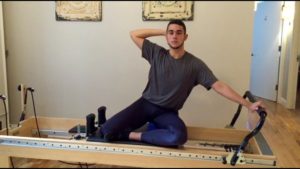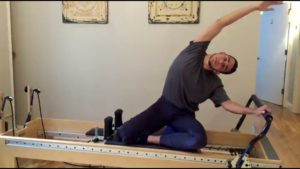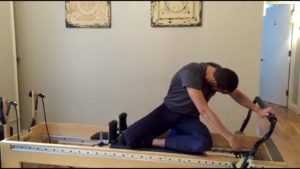“Merman” Featuring Andy Santana
Thank you Stacey Futterman and 5POINT!
The thoracic spine is responsible for:
a). Lateral translation of the ribs
b). Lateral flexion of the spine
c). Rotation of the spine
When we “remind the ribs” of these three movements, and in this progression, we are able to access greater ranges of motion of the thoracic spine with more ease. Try performing Mermaid on the Reformer by Reminding the Ribs. When you use this sequence, are you able to access new ranges?
Assessment:
- Perform your favorite Mermaid choreography on the Reformer.
- Note the sensation to the thoracic spine and available range of motion.
Set Up:
- One Red or Blue Spring. More spring tension will offer stronger feedback. Lower spring tension will require greater motor control.
- Z sit on the carriage with level sits bones. Use a yoga brick under one hip to assist in leveling the hips. The closer you sit towards the footbar, the more spring feedback you will draw from the machine.
- Hand on the footbar is slightly in front of the shoulder to encourage scapular depression. Gently externally rotate the humeral bone from the shoulder joint to increase congruency between the humeral head and genius fossa.
Exercise:
- Press the carriage out slowly maintaining rib cage stacked over the hips and spine neutral. Maintain an extended elbow as you range the spine in lateral translation, lateral flexion and rotation. *NOTE: The extended elbow creates a spring tension relationship with the Reformer. This spring tension relationship helps feed the brain information about how the spine is moving and from which segments.*
- Laterally translate the ribs, allowing the carriage to move. As the carriage glides further in and out from “home” the ribs are increasing their range for lateral translation.**
- Lead with the crown of the head and laterally flex the spine, keeping the carriage still. A still carriage will help you screen for faulty movement patterns of the lower spine and pelvis. In lateral flexion, the pelvis should remain neutral with both sits bones grounded and level. Open the rib cage by increasing the space between the ribs on one side and space between the ribs decreases on the other side.***
- Rotate the spine keeping the carriage still. A quiet carriage helps screen for unwanted movement of the pelvis and lumbar spine. Rotate from the thoracic spine only. Sits bones are anchored into the carriage.
Reassessment:
- Now perform your favorite Mermaid choreography again.
- Were you able to increase your range and ease of movement in the spine by performing the lateral translation first, lateral flexion second, followed by thoracic rotation?
- Did the MoveCoLab Set Up help your overall organization of movement?

*Step 1

**Step 2

***Step 3
SEE VIDEO
Did this MoveCoLab Tuesday Tip help?
Share your findings with us at info@movecolab.com
Written on August 2nd, 2016 ,





